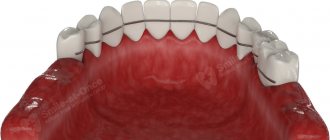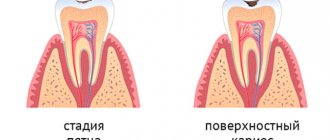Increased tooth abrasion is a process of increased tissue loss: first, the enamel becomes thinner, and then the inside of the teeth. Typically, the process of abrasion is constant - teeth gradually wear out throughout human life: first, the tooth enamel becomes thinner, and in old age it comes to the inner layers. Increased abrasion is a similar process that occurs at an accelerated rate: a real problem, and we will tell you how to deal with it.
The pathological loss of dentin and enamel is different in that it occurs much faster than with normal physiological abrasion. In this case, we talk about abnormal tooth wear, which is a recognized dental problem that mainly affects men over the age of 30. In this case, the decrease in the dental layer begins gradually, and as it progresses, it is no longer possible to influence the disease or cure it. That is why it is extremely important not to miss the initial stage of destruction of tooth enamel - so that tooth extraction, treatment and prosthetics are not required.
As a result, pathological abrasion of teeth occurs
The pathogenesis of the disease involves several factors, both external and internal.
| Endogenous factors | Exogenous factors |
| Metabolic disease. Gastrointestinal diseases. Pathology of the endocrine system. Bruxism (teeth grinding). | Patient's nutrition. Nature of working conditions. Incorrect prosthetics. |
The greatest influence on the abrasion process itself is exerted by occlusal forces, which have the following characteristics:
- The amount of chewing force. It is determined by the strength of the masticatory muscles, which can range from 80 to 400 kg. It is necessary to take into account that teeth are under stress not only when chewing food, but also when swallowing, and a person performs several thousand swallowing movements per day.
- Duration. During the day, the occlusal surfaces of the teeth come into contact with each other for half an hour, but with pathology, this figure can increase significantly.
- Application point and direction. The occlusal force is directed at right angles to the chewing surface of the tooth. Normally, the contact area is several square millimeters, but with pathology it can increase several tens of times, which leads to greater efforts when chewing.
In the presence of harmful production factors, bruxism, fluorosis and other reasons mentioned above, all characteristics of occlusal forces change for the worse, which leads to tooth abrasion.
Implantation of anterior upper tooth
Implantation of the upper anterior teeth will have its own characteristics, because the upper and lower jaws differ from each other in their anatomical structure and the set of functions they perform. When chewing food, the load falls predominantly on the lower jaw and therefore its bone has greater thickness and density compared to the bone tissue of the upper jaw. The thinness of the bone tissue of the upper jaw must be taken into account when implanting the upper anterior teeth. If you place an implant in the upper jaw carelessly, there is a risk of injuring the bone, which will increase the healing time of the artificial root.
In addition, the maxillary sinuses are close to the bone of the upper jaw and they can be easily damaged if the doctor is inattentive when installing implants. If the maxillary sinuses are injured during the implantation of the upper front teeth, an inflammatory process will begin in this area, which can lead to rejection of the artificial roots.
When implanting the upper front teeth, it is also important to choose the right prosthesis that will be placed on the artificial root abutment after its healing. For front teeth, dentures made of ceramic and zirconium are optimal - materials that are durable and at the same time aesthetic.
When to start treatment
The problem does not appear suddenly; it is characterized by a long course with gradual progression. The sooner treatment begins, the shorter and less radical it will be. That is why you should contact your dentist when the first signs of the disease appear, which include:
- Increased sensitivity of dentin.
- Reaction to hot and cold food.
- Changes in the color and shape of teeth.
- Early abrasion of enamel.
It must be remembered that there is also physiological abrasion of teeth. It is characterized by a long and slowly progressive course and is a consequence of the natural aging processes of the body. If a patient experiences rapid wear of enamel and dentin at a young age, then it is necessary to immediately contact a specialist for professional help.
How is pathology determined?
Only a specialist can detect a violation during tooth wear. Of course, the general picture among the population is taken as the norm, but the doctor also takes into account individual factors:
- general condition of the enamel;
- presence or absence of exposed dentin;
- work of the temporomandibular joint;
- condition of the mucous membranes of the tongue and cheeks;
- degree of severity of nasolabial folds;
- sensitivity of the masticatory muscles.
It is interesting that in addition to all the individual characteristics, the doctor is interested in the sound with which the jaws close. A sharp, clear and short sound indicates that there are no problems. A long-lasting sound accompanied by a squeak indicates deficiencies in the functioning of the TMJ or problems with the nervous system.
You can understand that teeth are subject to increased abrasion by the first sign - increased sensitivity. It is sharper when the upper hard layer of enamel is significantly abraded.
Patient examination plan
Traditionally, the examination begins with getting to know the patient, collecting anamnesis and complaints. At this stage, the doctor finds out when the disease began, how it manifests itself, what it may be associated with (the patient’s lifestyle, previous treatment, harmful occupational factors, etc.). If the problem has just begun to manifest itself, then complaints as such may be absent or only slightly expressed. Typically, patients note discomfort when eating hot and cold food, chipping of the enamel or its thinning, and changes in diction (in later stages of the disease).
At the next stage, the doctor proceeds to examine the oral cavity, during which he evaluates:
- Bite.
- Overlapping of incisors.
- The shape of the dentition.
- The shape of the teeth.
Based on the data obtained, the doctor can prescribe additional research methods (radiography, MRI, electroodontodiagnostics, etc.), as well as consultations with more specialized specialists.
How can you tell if the enamel is wearing off?
First, the top layer of enamel is affected - the tissue becomes more faded, and the bottom of the erosive lesion looks hard and smooth. A person experiences discomfort while eating due to increased tooth sensitivity. When eating too hot, cold or sweet food.
Many people mistakenly assume that worn enamel is a cosmetic problem. However, if the tissue surface is not restored in time, the enamel will continue to deteriorate, the damage will affect the dentin, and then the tooth pulp.
How to restore worn enamel?
What to do if the enamel on your teeth is worn away? Firstly, don’t worry - in the vast majority of cases, the tissue can be restored. And, if you recognize weakening teeth at an early stage, you can restore them to their former strength even at home.
In later stages of enamel destruction, you must consult a dentist. The doctor can perform one of the restorative procedures:
- Fluoridation of enamel
helps increase the resistance of teeth to aggressive substances - fruit acids, soda, tobacco. This treatment procedure can be used at any stage of enamel wear. - Placing fillings
will help restore the thickness of the enamel and strengthen damaged areas of the tooth. - Installation of veneers.
The thinnest plates installed on the teeth strengthen the enamel, replace the outer layer of crowns, and also correct the shape and color of the row. - Remineralization
or application of substances with calcium, fluoride, and vitamins to the teeth. The composition is absorbed almost instantly, covers damage and gradually strengthens the enamel.
If you notice that the enamel on your teeth has worn away in the initial stages of the disease, you can use home remedies to strengthen it. We have formulated several recommendations, following which you can restore the damaged layer.
- Be careful with products containing fluoride.
If you live in areas with high levels of fluoride in the water, you should never use fluoride toothpaste. Remember, excess fluoride is just as harmful as a deficiency of this element. - Eat right.
Do not forget that teeth need calcium, phosphorus, as well as vitamins D, A, K, C. Remember, dairy products, eggs, and raw vegetables and fruits are also useful for enamel. But it is better to avoid lemonade, alcoholic drinks and cigarettes to maintain dental health. - Include solid foods in your daily diet.
Carrots, apples, celery will help clean your teeth from food debris and perfectly strengthen the enamel. - Take good care of
your mouth and visit your dentist twice a year. - Massage your gums regularly.
With improved blood circulation, beneficial substances penetrate tissues faster and saturate them with vitamins. - Use natural remedies to strengthen enamel.
Tea tree solutions and herbal decoctions have proven themselves to be excellent. For thinned enamel, even rinsing with sea salt is helpful. To prepare a saline solution, simply dissolve 4 teaspoons of salt in half a glass of water. - Remember about folk remedies.
Even in Soviet times, activated carbon, lemon zest, and baking soda served as faithful assistants in the fight for strong, healthy teeth.
A useful product for enamel is green tea. Just one glass of this refreshing drink a day will help reduce your chances of losing teeth by 15-20% and strengthen your enamel.
Dentists recognize ASEPTA PLUS toothpaste Remineralization as one of the most effective means of strengthening worn enamel. This product is designed to strengthen weakened enamel and protect gums from inflammation. The paste contains hydroxyapatite, a source of natural bioactive calcium and phosphorus, thermal mud, the enzyme papain, which breaks down plaque, zinc and potassium, as well as extracts of Eleutherococcus and calendula, which accelerate the regeneration processes of the oral mucosa (a special case during pregnancy).
Treatment methods
Treatment of pathological tooth wear may include therapeutic and orthopedic techniques. In the first case, there are two options:
- Drug therapy (includes the application of gels and solutions, the use of special toothpaste).
- Restoration (special filling material is used).
Orthopedic treatment involves the manufacture and installation of onlays, dentures or crowns, which restore the normal appearance and functionality of teeth.
Currently, dentists do not agree on the timing of initiation and specific treatment methods in different situations. Most often, drug treatment is used in patients in the early stages of the disease, when the teeth are not yet seriously damaged. For more severe pathology, restorative and orthopedic treatment is indicated.
Causes
There are several reasons for tooth wear. Changes in the shape of units can occur against the background of various diseases or when exposed to external factors.
The causes of pathological abrasion include:
- Uneven load. The pressure on the teeth may be distributed incorrectly due to the absence of some units.
- Bruxism. A disease characterized by grinding sounds. Most often, patients are not aware of the presence of pathology, since uncontrollable grinding of teeth appears at night.
- Profession. Workers in certain professions are forced to be in hazardous conditions when performing their job duties.
Constant exposure to chemicals and toxic substances negatively affects the condition of the skin and surface of the teeth, destroying their structure. Wear of enamel and dentin occurs much faster. - Insufficient tissue hardness. With certain diseases of the oral cavity, deterioration of the upper layers of teeth is observed. The enamel becomes thinner, as a result of which it begins to wear off faster.
- Systemic pathologies. Pathologies such as metabolic disorders and endocrine system disorders can reduce the resistance of hard tissue. They have a negative effect on tissue structure.
- Abnormal bite. If the jaws are not positioned correctly, rapid wear of the edges of the incisors and canines is observed.
- Poor nutrition. Eating carbonated drinks, sweets, flour products and hard foods causes deterioration in the health and condition of tooth enamel.
- Drinking alcohol and smoking. Nicotine and alcohol have a negative impact primarily on enamel, causing the development of caries and other oral diseases.
- Bad functional habits. These include holding foreign objects in the mouth, such as pens, toothpicks, fingers. As a result, cracks and chips appear on the enamel.
- Use of certain groups of medications. Preparations based on hydrochloric acid lead to the destruction of enamel and dentin.
Pathological abrasion is established in people whose professional activities involve lifting heavy objects. This is due to the tight closure of the jaws when performing work.
Areas of application of metals in dentistry, their alloys, characteristics, advantages and disadvantages.
Come here if you are interested in modern types of impression materials used in orthopedic dentistry.
At this address https://zubovv.ru/protezirovanie/nesemnyie-p/koronki-np/plyusyi-i-minusyi-farforovyih.html we will talk about the technology for making porcelain crowns.
Restoration of worn teeth
Restorative treatment is carried out while preserving at least half of the hard tissues of the tooth. The technique takes place in several stages:
- Preparation. Necessary to identify the causes of diseases and their elimination or minimization, as well as the protection of remaining teeth. During preparation, an occlusal splint is made and installed if the patient suffers from bruxism. If necessary, the doctor prescribes consultations with various specialists, explains the rules of oral hygiene, and sanitizes foci of infection.
- Evaluation of the preparatory stage. After some time, the patient comes for an appointment, and the doctor assesses the condition of the teeth, checks whether the patient followed all the recommendations correctly, and discusses the upcoming treatment with him.
- Restoration. It is carried out in a certain order. First, the teeth are prepared, then the teeth on the upper jaw are restored, and only then on the lower jaw. Using a table of anthropometric data for each tooth, the doctor gives the patient's new teeth a certain length and shape.
- Observation. After successful treatment, the doctor observes the result for some time. In the first year, the patient should come for an appointment once a month, then less and less, but not less than once every 12 months. If any defects are identified, they are repaired or other treatment methods are applied.
This type of treatment, like any other, requires the patient to strictly adhere to all recommendations, give up bad habits, eat right, regular examinations by a specialist, and carefully observe hygiene skills.
Implantation of the front lower tooth
There are no maxillary sinuses in the lower jaw, but this does not mean that the implantation of the lower anterior teeth can be carried out with less care and without precise planning. In the area of the lower jaw there passes the ternary nerve, which, if the implantation of the lower anterior teeth is not planned correctly or if the implantologist is insufficiently professional, can be easily injured and this can be fraught with serious complications after the operation.
In particular, if the implantation of the lower anterior teeth is performed incorrectly, the patient may encounter complications such as numbness of the lower jaw or severe swelling in the area where the implants are implanted.
Implantation of the front teeth - both lower and upper - can be carried out according to different protocols - one-stage or classic, two-stage. The choice of technology for implanting anterior teeth is carried out according to diagnostic data and it is important that the diagnostic equipment is modern and ultra-precise. In our dental clinic in Moscow - “Aesthetica”, a Planmeka computed tomograph is used for diagnostics before implantation, which allows the doctor to obtain all the data on the structural features of the patient’s jaws, the condition of the bone tissue and plan the implantation of the front teeth so that the operation is carried out without the slightest inaccuracies and errors!
Crown as a way out
Pathological tooth wear can be eliminated with the help of crowns. They can be installed both on the front teeth and on the chewing teeth and restore the aesthetics and functionality of the oral cavity. Crowns can be made from various materials, each of which has its own advantages and disadvantages:
| Material | pros | Minuses |
| Metal ceramics | Durability, high aesthetic qualities, not the highest price | Depulpation of the tooth and grinding of a large amount of hard tissue are required. |
| Metal-free ceramics | The best aesthetics that are not lost over time, high strength, durability. | High price. |
| Metal | High strength, durability, low cost. | Lack of aesthetic qualities. |
When choosing a certain material, the patient must understand that he will need to replace a large number of crowns (perhaps even all). Therefore, it is worth giving preference to those materials that have good aesthetic qualities and a long service life.
After all the nuances of prosthetics have been agreed upon, we proceed directly to the procedure itself. At the first stage, the oral cavity is sanitized and teeth are prepared for crowns. Next, the doctor takes impressions of the jaws, based on which the dental technician makes a prosthesis. These operations may take some time, so the patient may be offered temporary plastic crowns. They will protect prepared teeth from the aggressive environment of the oral cavity and help adapt to new teeth. After the final version of the prosthesis is ready, it is tried on again and fixed with permanent cement.
First of all, treatment, not aesthetics
If you are not satisfied with the appearance of your teeth, any changes should begin with a visit to a dental therapist, not an esthetician. While there are functional problems, it is impossible to move on to those procedures that only improve the appearance of teeth.
Therefore, if the teeth are uneven, orthodontic treatment is the first step. Aligners are the most modern way to correct a bite, because they are comfortable and unnoticeable. With them, treatment is not only quick, but also psychologically simple for the patient: there is no need to get used to new restrictions, brushing teeth with the help of special devices, or even the appearance of the structure.
There are no age restrictions for wearing aligners: they can be worn by children from the moment a permanent bite has formed, by teenagers and by adults.
If individual teeth are missing, there are two options:
- In some cases, you can close the gap between adjacent teeth with the help of aligners, form an even and dense row of teeth and do nothing else. If a chewing tooth (5–7th) was missing, then visually it will not be noticeable. But functionally this method is not the best, since the symmetry of the dentition may be disrupted. In addition, this way you can hide the absence of at least one tooth.
- Prepare the site for implantation using orthodontic treatment. Then carry out implantation. The method takes longer, but the result is complete restoration of the functionality of the teeth.
The place for the implant is prepared while wearing aligners.
The treatment procedure is exactly this: first, the bite is corrected, then the implants are installed. Once the implant is installed, the teeth should no longer move. Implants are designed to be installed with correct bite (closure). If the teeth close together in such a way that the load during chewing is distributed unevenly, then the implant will either receive less load or receive excessive load. Both are unacceptable. Any experienced doctor will refuse to place an implant if there is a malocclusion, as he will not be able to provide a guarantee for his work.
First - to the orthodontist, then, if necessary - to the implantologist.
Restoration and normalization of the dental system
These tasks are implemented during orthodontic treatment. The correct position of the teeth and physiological bite not only improve the aesthetic function of the oral cavity, but also contribute to the uniform distribution of the load on the teeth. To achieve such results, orthodontic appliances are used, which can be removable or non-removable. In the first case, the Dahl method is used, the essence of which is that a pre-made bite pad is installed on the inner surface of the front teeth, which is necessary for uniform distribution of pressure vertically. The platform is fixed with clasps to the supporting teeth (usually canines and premolars); if necessary, the patient can remove it independently.
Fixed appliances are permanently fixed in the oral cavity for a long period of time; they are secured with cement, so the patient cannot remove them. The most popular are the Angle apparatus, the Ainsworth apparatus, the Simon apparatus, etc. Correctly selected orthodontic treatment can make the upcoming restoration or prosthetics simpler and more effective.
Modern materials and treatment methods in dentistry make it possible to successfully combat pathological tooth wear. The interaction between doctor and patient is very important. The specialist must choose the right treatment method and give the patient all the necessary recommendations, which he must strictly follow. The responsibility of both parties will be a good guarantee of a successful fight against the disease.
Front tooth implantation for bone atrophy
Is it possible to place an implant if the jaw bone tissue is atrophied? Yes, but implantation of the front tooth in case of bone atrophy will require preliminary bone grafting - sinus lifting, if the implants are implanted in the upper jaw, or replanting of bone blocks during surgery on the lower jaw. The choice of bone grafting technique is carried out individually for each patient. After the tissue is restored and the bone tissue acquires the required height and volume, implantation is performed.
IMPORTANT: In some cases, a front tooth implant can be placed at the same time as bone augmentation surgery. Is it possible to combine implantation with bone grafting in your case? Only an implantologist can answer this question after diagnosis.
In case of bone tissue atrophy, the implantation of anterior teeth is carried out using a classical two-stage technology, which involves dividing the operation into two stages: the stage of implantation and the stage of permanent prosthetics. At the first stage of the operation, the doctor will install not only implants, but also a special device - a gum former, which allows you to obtain a beautiful and natural contour. The doctor will place a permanent prosthesis on the implant only after the artificial root has completely engrafted, and this usually takes about 4-6 months.
IMPORTANT: If you decide to place implants on your front teeth, you should know that the result of treatment depends not only on the professionalism of the doctor and the type of implants, but also on you. Before the operation, you must provide the doctor with honest and detailed information about the state of your health, and after implantation, strictly follow all the specialist’s recommendations!
Prevention
To reduce the risk of pathology and slow down the process, it is recommended to follow a number of simple rules:
- eliminate the consumption of alcoholic beverages, coffee, quit smoking;
- limit the intake of solid foods, sour, sweet foods and flour products;
- include foods high in calcium in your diet;
- get rid of bad habits;
- promptly treat all oral diseases;
- Maintain hygiene, brush your teeth daily, use dental floss.
Following the rules of prevention will help slow down the development of pathology. If symptoms occur, you should immediately contact a specialist.
Reviews
Modern dentistry offers many methods for correcting excessive tooth wear. The choice rests with a specialist who relies on examinations and assessment of the clinical case.
What recovery method was used in your case? How effective was the treatment? What advantages and disadvantages can you note? Share your experience of dental restoration in the comments to the article.
If you find an error, please select a piece of text and press Ctrl+Enter.
Tags fixed dentures prosthetics teeth abrasion
Did you like the article? stay tuned
Price
When diagnosing pathological tooth abrasion, the cost of treatment directly depends on the method of restoration, the material used and the degree of damage:
- The most expensive are ceramics (from 20,000 rubles) and zirconium dioxide (from 40,000 rubles).
- Plastic is considered the cheapest, but unreliable . Its cost varies from 400 to 700 rubles.
- The price for stump inlays starts from 5,000 rubles. The cost depends on the material and manufacturer.
- Microprosthetics is a complex and labor-intensive process, the price of which starts from 6,000 rubles.
From the video, learn about the most common causes of increased tooth wear and methods of getting rid of the problem.











